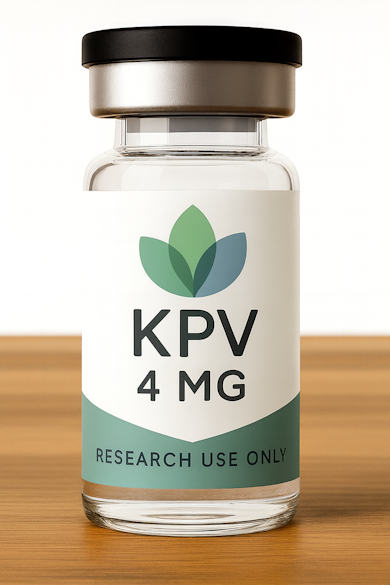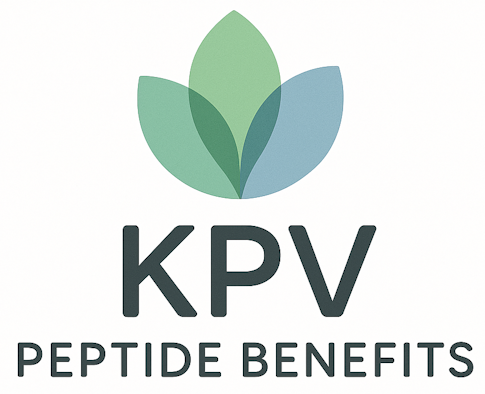The KPV peptide (Lysine-Proline-Valine) is one of the most studied therapeutic peptides in the family of melanocortin peptides, derived from alpha melanocyte stimulating hormone (α-MSH). Its anti inflammatory and immune-modulating properties have gained attention in clinical studies for their potential to support gut health, skin healing, and tissue repair without the harsh side effects seen in many anti inflammatory drugs.
The KPV peptide mechanism of action has been the focus of laboratory research exploring how this tripeptide regulates inflammation and immune balance at the cellular level.
What Makes KPV Unique

KPV is a tripeptide composed of the amino acids lysine, proline valine, which interacts at the cellular level to regulate cytokine production, reduce pro inflammatory cytokines, and modulate immune response. This targeted approach to controlling inflammation supports wound healing, tissue regeneration, and immune function across multiple systems.
Unlike typical anti inflammatory drugs, KPV peptide therapy provides anti inflammatory action by inhibiting NF κB activation, a key pathway involved in chronic inflammation, autoimmune diseases, and inflammatory bowel disease. Animal models show that peptide KPV can help restore immune system balance, aiding both inflammation control and tissue healing.
KPV Peptide Dosage Guidelines
While research on human dosing is still evolving, the KPV peptide dosage typically ranges from 250 mcg to 1 mg daily, depending on delivery method and individual factors. The peptide can be administered via oral capsules, subcutaneous injection (reconstituted with bacteriostatic water), or orally targeted delivery systems for localized effects in the gut.
For a detailed look at how it compares with other gut-healing peptides, see our KPV Peptide vs BPC-157 comparison guide.
Here’s an example of the dosage you could expect for both men and women based on weight category:
| Weight Category | Men (Daily Dose) | Women (Daily Dose) |
|---|---|---|
| < 150 lbs (68 kg) | 250–500 mcg | 250 mcg |
| 150–200 lbs (68–90 kg) | 500–750 mcg | 300–500 mcg |
| > 200 lbs (90+ kg) | 750–1000 mcg | 500–750 mcg |
For chronic inflammation, ulcerative colitis, and inflammatory bowel conditions, divided doses (morning and evening) are often more effective for maintaining steady immune activity and supporting gut health.
How To Take KPV Peptide
Preparation, Mixing, and Administration
The KPV peptide is commonly used in research exploring its role in gut health, immune function, skin healing, and tissue repair. Because it is a therapeutic peptide with anti-inflammatory and immunomodulatory properties, the peptide must be handled carefully to preserve stability and biological integrity. Below is an overview of the typical preparation, mixing, and administration methods used in laboratory and preclinical settings.
(This information is intended for educational and research-context reference only, not for self-administration or medical use.)
1. Reconstitution and Mixing
KPV is usually supplied in lyophilized powder form within a sterile glass vial. To prepare it for research, scientists reconstitute the peptide with bacteriostatic water (water containing 0.9% benzyl alcohol to prevent bacterial growth). This process restores the peptide to a usable liquid state.
- Step 1: Wipe the tops of both the bacteriostatic water vial and the KPV vial with an alcohol swab.
- Step 2: Draw the desired volume of bacteriostatic water into a sterile syringe.
- Step 3: Insert the needle into the KPV vial at an angle, allowing the water to gently flow down the inside wall rather than directly onto the powder. This prevents foaming and preserves the peptide bonds.
- Step 4: Let the vial sit undisturbed for several minutes. Do not shake. The peptide will dissolve completely on its own or with a light swirling motion.
Typical research concentrations fall within 5–10 mg/mL, depending on the planned experimental dosage and delivery route. After mixing, the reconstituted peptide is refrigerated (2–8°C) and kept away from light. Stability in this state is generally maintained for several weeks.
2. Routes of Administration
Researchers use multiple routes of administration depending on the focus of the study:
- Subcutaneous injection – The most common route in animal models studying inflammation, tissue healing, or immune response.
- Oral or encapsulated delivery – For studies on inflammatory bowel disease, ulcerative colitis, or leaky gut, where KPV’s anti-inflammatory effects on the intestinal barrier are being observed.
- Topical or transdermal formulations – Used in dermatologic studies focusing on skin health, wound healing, and inflammation control.
When used subcutaneously, KPV peptide therapy is typically injected into areas with a layer of subcutaneous fat, such as the lower abdomen or thigh. The peptide is drawn into an insulin syringe and injected at a shallow 45-degree angle, ensuring it enters the subcutaneous tissue rather than muscle.
3. Injection Practices in Research Settings
In laboratory research, dosing is commonly divided into once- or twice-daily administrations to maintain consistent plasma concentration and anti-inflammatory activity. Animal studies have shown improved tissue regeneration and wound healing with repeated exposure, correlating with reduced pro-inflammatory cytokines and normalized immune function.
Researchers note that because peptides are delicate amino-acid sequences, they should be handled gently and stored under controlled conditions to prevent denaturation. Needles, syringes, and vials must always remain sterile to prevent contamination and ensure reliable study results.
For a closer look at its safety data and clinical tolerability, visit our KPV Peptide Side Effects overview.
Key Benefits and Therapeutic Potential
The therapeutic peptides like KPV are known to promote healing and tissue repair through anti inflammatory properties and antimicrobial support against common pathogens. By reducing reactive oxygen species and restoring barrier function in leaky gut, KPV peptide therapy enhances overall wellness and helps patients experiencing autoimmune issues, chronic pain, and skin conditions.
KPV’s influence extends to skin health and wound healing, where it accelerates the healing process, mitigates inflammatory processes, and aids in recovery from infection and damage. Some animal studies even suggest hyaluronic acid functionalized nanoparticles can improve KPV’s systemic applications, expanding its therapeutic potential.
You can learn about sourcing research-grade compounds in our guide on where to buy KPV peptide online, or see our complete KPV Peptide benefits article to understand its benefits on a deeper level.
Clinical Context and Research Insights
Evidence from research and animal models suggests that melanocyte stimulating hormone α and stimulating hormone α MSH derivatives like KPV reduce inflammation effectively, with few side effects compared to many anti inflammatory drugs. This makes KPV safe and valuable for long-term peptide therapy aimed at supporting immune function, mitigating chronic inflammation, and improving skin healing.
Furthermore, peptides work synergistically to support peptide therapy outcomes when combined with lifestyle measures that reduce body fat, enhance immune response, and restore gut health.
Summary
In summary, KPV offers a well-tolerated, anti inflammatory solution that aids tissue healing, boosts immune function, and promotes skin health and gut health. Its anti inflammatory effects, driven by the modulation of mast cells and suppression of inflammation, provide a targeted approach to supporting patients dealing with autoimmune diseases, inflammatory bowel disease, and chronic inflammation.
As ongoing research explores new multiple routes of administration, from oral capsules to advanced delivery systems, KPV peptide continues to stand out as a therapeutic peptide with vast systemic applications and remarkable anti inflammatory benefits.
For further reading, visit our official KPV Peptide Benefits homepage.
